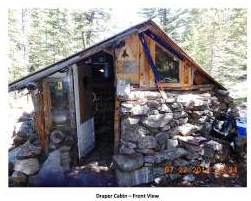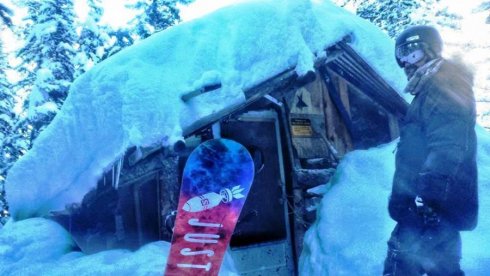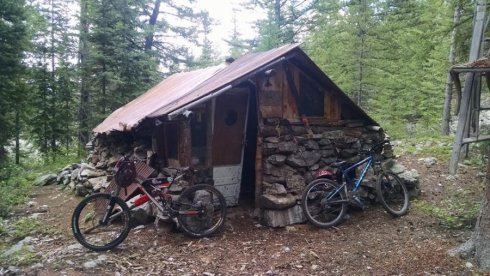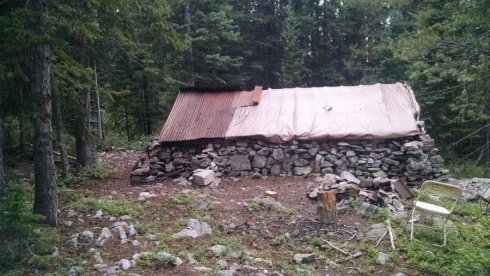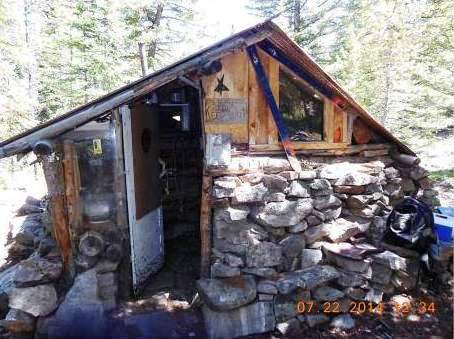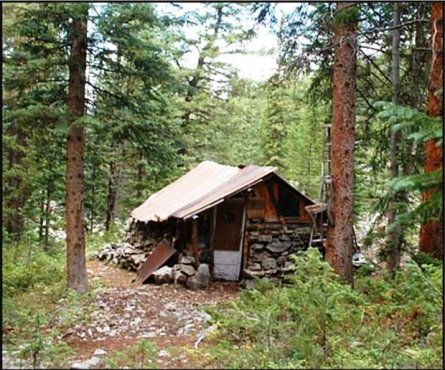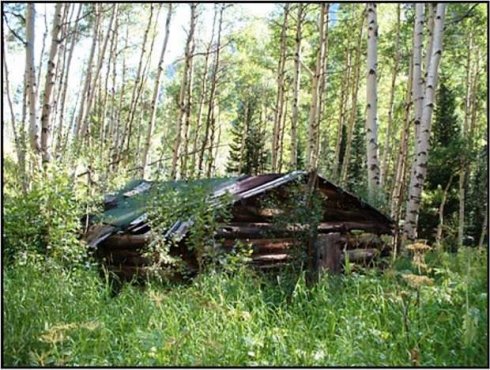The Draper Cabin/Burnt Mountain Cabin (Snowmass)
The Draper Cabin/Burnt Mountain Cabin is a warming hut that, as of 2017, had been used for over 30 years by backcountry skiers on Burnt Mountain.
According to an article in the August 28, 2014 Aspen Times by Scott Condon, the U.S. Forest Service was studying whether to demolish the hut. Here is the link to the article: https://www.aspentimes.com/news/forest-service-considers-demolishing-burnt-mountain-cabin/ The first photo below appeared with the article. Photo credits for other photos are shown below.
Also see this August 2015 article (and also two 2017 articles below the photos): http://ski.curbed.com/2015/8/25/9927124/burnt-mountain-backcountry-cabin-is-declared-off-limits
________________________________________________________________________________
____________________________________________________________________________
Six cabins scattered on national forest surrounding Aspen are targeted for demolition this summer in a mine lands safety-closure project. At least a portion of five of the structures dates back to the late 1800s or early 1900s, but none qualify for the National Register of Historic Places or the Colorado State Register of Historic Places. One of the cabins has been used for 30 years as a warming hut for backcountry skiers on Burnt Mountain. "They might not have historical significance but they might have historical value," said Aspen-Sopris District Ranger Karen Schroyer. Therefore, her formal decision on the project calls for the reclamation crews "to leave a trace of historic building components, if possible, for gradual deterioration so visitors can enjoy and ponder the local history while visiting their public lands. Partial walls, no taller than 3 feet, will be left on some of the structures, but all roofs, windows and doors will be removed." The Forest Service is facing a dilemma. Federal law requires the agency to keep standing cabins in safe and good condition. The White River National Forest doesn't have the money to do that, so the agency is tapping a state of Colorado fund maintained to make mine lands safer by closing off mines and demolishing old structures. The Forest Service has an obligation under the National Historic Preservation Act to study if any of the structures targeted for demolition are eligible for listing rather than destruction. A report prepared by Mountain States Historical of Lafayette determined several of the cabins were remodeled or sometimes completely overhauled in the 1960s through 1990s for recreational use and squatting. That compromises their historic integrity. One targeted structure, a dilapidated old building near Warren Lakes on Smuggler Mountain, had no historical value at all, Schroyer said. It wasn't evaluated in the study. "That one has been abandoned for some time," she said. Two of the cabins are located at the end of the road at the ghost town of Ruby, east of Aspen. The Osborn cabin was likely built between 1903 and 1910 on a mining claim at 11,500 feet in elevation. "The cabin was almost certainly a prospector's or miner's residence, and among Ruby's few businesses," the historical report said. "The cabin was heavily remodeled several decades ago with new siding, recreational decks, a roof, door, downs, drainage improvements and other elements," the report added. "The site's integrity is severely compromised. The cabin exhibits only a fraction of its original design, materials and workmanship. Without these aspects, the site has no clear association with Ruby's history. But the site's alpine setting is outstanding and impacts feeling of prospecting circa 1900." Remnants of the original cabin will be left behind after the modern elements are torn down and trucked out. Another cabin and outhouse at the end of the road at Ruby will be completely removed. Some recreational cabins and storage structures were "erected haphazardly" in the 1960s into the 1980s among the ruins of cabins that date back to the 1880s and early 1900s on the Columbine lode, the report said. The newer structures will be torn down and removed, along with the remains of a 1940 Hudson automobile. An unauthorized bridge across Lincoln Creek also will be torn out. The warming hut known as the Draper cabin also is meeting its demise within Snowmass Ski Area. It is tucked among steep slopes on Burnt Mountain and is tough to stumble upon. Its use since the mid-1990s has been mostly through word of mouth. Users of the structure criticized the Forest Service's planned demolition back in 2014 as a solution looking for a problem. The users, who didn't want to be identified for fear of getting stuck with a bill for cleanup, said the structure isn't unsafe and is causing no harm in the woods, they said. The original cabin was likely built in the 1910s and is surrounded by prospect pits. It was abandoned around 1920 and collapsed. "During the 1990s, someone used the ruins as a core for a recreational shelter, adding to the walls, changing the footprint and installing a new mudroom," the report said. "The site's integrity is compromised. The cabin possesses only a fraction of its original materials and workmanship and no aspects of design." Two of the cabins haven't been bastardized as much as the others, but they are still getting demolished. The Vermont cabin in Conundrum Valley was likely built by prospectors between 1897 and 1920 and used as a base camp for exploring the area, Mountain States Historical said. Recreationists started using it and made alterations in the 1970s and '80s. It has its original door and some windows and in the interior it appears to have original shelving, a cabinet and a cookstove. But recreation users added Plexiglas, bar stools and a 1977 movie star catalog. The cabin is in an advanced stage of deterioration, the report said. It's in designated wilderness, so crews will demolish it by hand. Schroyer ruled they will leave 3 feet of the walls intact on the Vermont cabin. All disassembled wood components will be left scattered on the ground. The sixth cabin assessed for the project and the most historically intact also will be dismantled with 3 feet of walls remaining. The Emily lode cabin is located at the entrance road to the Anderson and Petroleum lakes entrance route along Lincoln Creek, north of Ruby. Mountain States Historical estimated the cabin was built by prospectors between 1897 and 1915. "The cabin itself is fairly well preserved, suffering only a few substantial alterations in recent decades," the report said. "Recreationists replaced windows, added a large deck in front, bolted on a radio antenna, and installed fittings for a freshwater hose and propane service. The roof may have been re-clad as well. But the rest of the building appears to be original and structurally sound." Again, while the report found there was no historical significance, it also noted a special quality of the Emily lode cabin. "A deep forest setting supports a feeling of remote residence by prospectors," the report said. Schroyer said Monday she is torn by a desire to preserve mining era history but abiding by the law that all structures on national forest must be safe. Leaving 3-foot high walls will preserve a historical record of three of the structures. "I felt like that was my compromise," Schroyer said. She noted that none of the structures targeted for demolition were ever authorized. The mining claims weren't patented — meaning the work wasn't performed to convert them into private property. The opportunity to make them safe came through a state program, Schroyer said. It pays for the closure of mining workings and also the demolition of associated structures. The cost of the program wasn't available Monday.
____________________________________________________________________________
These two photos were part of the Aspen Times article below. Click on images to enlarge.
Larry Frederick has spent considerable time exploring mining ruins and artifacts in Aspen's backcountry and said he agrees with a U.S. Forest Service plan to tear down six shacks this summer. A historian who volunteers extensively with the Aspen Historical Society and has immersed himself in studies of Aspen's mining and ranching history, Frederick said the targeted cabins have been altered to the point where they have lost their integrity. "There's nothing around there of historical value anymore," he said. If people had left historic resources untouched it would be a different story, he said. But the original miner's cabins were altered decades ago. The alterations, destruction and removal of artifacts are a product of the sheer numbers of people hiking, biking and traveling in the backcountry. "We've loved it to death — the same old story," Frederick said.
The Forest Service will implement what is labeled the Greater Aspen Abandoned Mine Lands Safety Closure Project. Crews will dismantle three cabins and two outhouses near the ghost town of Ruby, one at Snowmass Ski Area, one at Warren Lakes on Smuggler Mountain and one in Conundrum Valley. The agency has a legal obligation to make sure any structures in the national forest don't pose a safety hazard, Aspen-Sopris District Ranger Karen Schroyer said. The Forest Service doesn't have the funds to maintain the cabins, especially if they don't have historical significance. The National Historic Preservation Act requires resources targeted for demolition be assessed for historical significance. The Forest Service commissioned an independent study by Mountain States Historical, a firm from Lafayette, that concluded the structures don't qualify for national or state historical registries. Portions of every cabin except the one at Warren Lakes date back to the late 1880s or early 1900s. But in every case they were altered by major additions — in the 1970s, '80s and '90s. "All inventoried resources are recommended not eligible because of insufficient integrity and/or significance," the report concluded. Frederick read the report and concurred with the conclusions on each cabin. Schroyer said the cabins might have "historical value" even if they aren't eligible for state or national historical designation. Therefore, she said, she found a compromise decision that will allow original wood components to be left on site at three of the cabins. The walls will be dismantled down to 3 feet, with all windows and doors removed. The idea is "to leave a trace of historic building components, if possible, for gradual deterioration so visitors can enjoy and ponder the local history while visiting their public lands," Schroyer's decision said. The materials of three other cabins aren't worth scattering on site and will be removed, according to the decision. "In this particular case, I think the Forest Service has come up with the best solution," Frederick said. Other people disagree. In a reader comment attached to an earlier story about the planned demolition of the cabins, M. Bridget Bielinski wrote, "That's a shame. Those structures add to the sense of place in those areas. Too bad the Forest Service can't get some sort of waiver from its obligation to keep those structures in 'safe and good condition.'" The Forest Service has played a critical part in helping preserve historical sites around Aspen. It was a partner with local entities to preserve historic structures at Independence and Ashcroft ghost towns. Outside of those areas, not many mining-era artifacts still exist around Aspen — certainly not to the extent that they do in the San Juan Mountains, Frederick said. "There are a few surprises here and there," he said. Nature takes its toll, he noted, and scrap iron collection drives during World War II and probably World War I stripped many mine sites of their artifacts. Funding for the project will come from a state of Colorado program to seal mines and demolish unsafe structures on mining lands.
